You’ve probably seen the phrase “high-converting landing page“ thrown around like it’s magic. But let’s be real—most landing pages aren’t converting anything.
They’re too busy, too confusing, or just flat-out boring. And people? They click away in two seconds.
If you want a landing page that makes people do something—like buy, sign up, or click through—then yeah, you need to rethink the basics.
Here are 5 real, practical tips to create a high-converting landing page—not theory, not fluff, just what works.
5 Tips to Create a High-Converting Landing Page
1. Keep it stupid simple (especially the top)
Most people don’t scroll.
They land. They glance. They leave.
Unless something grabs them right away. So the top part of your landing page—what’s called the “above the fold” section—has to do one job: tell them exactly what this page is about and what they should do next.
Like… immediately.
Here’s how to do that:
- Use a clear headline. Not clever. Not vague. Just straight to the point.
- Follow up with a short subheadline that explains the value or benefit.
- Add one call-to-action (CTA) button. Not five. Just one.
Example:
If you’re offering a free ebook on running faster:
Headline: “Run Faster in 30 Days—Without Extra Training”
Subheadline: “Grab our free ebook with simple drills that work”
CTA button: “Download the Free Ebook”
That’s it. No distractions. No carousel sliders. No “About Us” section. Just clarity.
2. One page, one goal
Here’s where most people mess up.
They try to do too much on one landing page. Like promote a product, collect emails, share testimonials, and link to their blog—all at once.
Don’t do that.
A high-converting landing page has one single goal. Nothing else.
If your goal is email signups, every part of your page should lead people to that.
If it’s to sell a product, focus only on that product and why it’s worth it.
Ask yourself:
- What’s the one thing I want someone to do on this page?
- Does every element on the page support that action?
If it doesn’t help the goal, cut it out.
3. Use social proof (the real kind)
People don’t trust you. Yet.
And that’s okay. It’s normal. You have to earn it.
One of the fastest ways to do that? Show proof that other people trust you.
Not fake reviews. Not cheesy testimonials. Real stuff.
Here’s what works:
- Short quotes from actual customers with names and faces (not “John D.”)
- Logos of brands or clients you’ve worked with
- Data like “10,000 downloads” or “Over 1,000 happy members”
- Screenshots of tweets, emails, or DMs from real users
The key here is authenticity.
Don’t use stock photos. Don’t make things sound too polished. Let it feel human.
Quick tip:
If you’re just starting and don’t have testimonials yet, run a free trial or beta and ask for honest feedback. Even two real quotes can go a long way.
4. Write like a human, not a brochure
If your copy sounds like it was written by a marketing robot… people are gone.
People don’t read long paragraphs. They skim. They scroll. They’re impatient.
Your copy needs to feel like a real conversation. Like you’re explaining something to a friend.
Here’s how to do that:
- Use short sentences
- Break things up with bullet points
- Avoid jargon or buzzwords
- Use second person (“you” and “your”)
- Be clear about the benefit, not just the feature
Example:
Instead of saying:
“Our platform leverages cutting-edge tools to streamline the email process.”
Say:
“Send emails faster without getting buried in tech.”
Which one would you rather read?
5. Make the CTA stupidly obvious
You can do everything else right, but if people don’t notice your call-to-action… It’s game over.
A high-converting CTA needs to:
- Stand out visually (big button, contrasting color)
- Use action words like “Get,” “Download,” “Start,” “Try”
- Tell them what happens next (“Start free trial,” “Download your copy”)
And most importantly?
Don’t hide the button at the bottom. Place it multiple times on the page—after your pitch, after your testimonials, even halfway through your content.
Let people take action when they’re ready.
CTA examples that work:
- “Start My Free Trial”
- “Send Me the Checklist”
- “Yes, I Want In”
- “Get Instant Access”
Avoid vague stuff like “Submit” or “Click Here.” That doesn’t tell anyone anything.
Bonus Tips That Help (If You’re Serious)
Here are a few more small things that can make a big difference if you’re trying to improve your conversion rate.
A/B test everything
No one gets it perfect the first time.
Try different headlines, button text, images, or even layouts. Use a tool like Google Optimize or ConvertKit.
Even tiny changes—like button color—can move the needle.
Load time matters
Slow pages kill conversions.
Use tools like GTmetrix or PageSpeed Insights to see what’s slowing you down. Compress images. Use fewer scripts. Keep it lean.
Mobile-first, always
Most people are on their phones. If your landing page is hard to read or scroll on mobile, you’re losing traffic fast.
Check it on multiple devices. Make the buttons big enough. Keep forms short.
Use real images
Stock photos look fake. You know it, I know it.
If you can, use a real photo of yourself, your product, or your team. It makes you more relatable.
Even a casual photo taken on your phone is better than a glossy stock image.
Why These Tips Work (EEAT and all that)
Okay, if you’re wondering why these things matter in the big picture—especially if you care about SEO—here’s the deal.
Google’s EEAT framework stands for:
- Expertise
- Experience
- Authoritativeness
- Trustworthiness
In plain English?
Google ranks pages that feel real, helpful, and created by people who know what they’re talking about. So if your landing page is trying to sell something or collect info, it needs to feel legit.
- Show your face or name? That’s trust.
- Offer helpful info, not hype? That’s expertise.
- Use real proof or data? That’s experience.
Basically, if your page feels sketchy, generic, or lazy… it won’t rank and it won’t convert.
But if it feels honest, useful, and human, it’ll do way better.
Let’s bring it all together, fast.
- Keep the top section clear—Headline, subheadline, CTA.
- Focus on one goal—Don’t distract people.
- Use real social proof—Not fake quotes.
- Write like a person, not a robot.
- Make your CTA obvious and action-based
You don’t need to be a designer. You don’t need to hire anyone fancy.
Just stick to what works. Keep things simple. Make it easy for someone to say “yes.”




